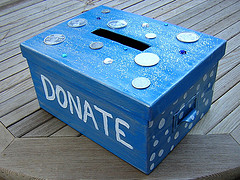 R.C.A. is about getting folks walking; not just talking. It’s about good content and conversation that leads to your desired action. It refers to Relatable, Part I, Conversational, Part II, and Actionable. You remember this acronym by thinking about an RCA Victrola – that old-fashioned phonograph contraption that helped transport your grandparents and great-grandparents — and fire their imaginations — through the music that inspired them.
R.C.A. is about getting folks walking; not just talking. It’s about good content and conversation that leads to your desired action. It refers to Relatable, Part I, Conversational, Part II, and Actionable. You remember this acronym by thinking about an RCA Victrola – that old-fashioned phonograph contraption that helped transport your grandparents and great-grandparents — and fire their imaginations — through the music that inspired them.
You want to transport your constituents with inspiring values and stories in the same way. The reason you want to transport them? So their inspiration will lead to engagement — action that helps to further your mission. So, today that’s what we’re going to talk about! Ready for action?
ACTIONABLE ENGAGEMENT
This is a good time to remind yourself that your nonprofit blog has a purpose. Take a minute to think about what this is. Don’t be too general. Get specific. What do you want folks to learn… think… feel… do… after reading your blog post? Don’t be flip about this. Think.
Okay… know what you want from folks?
Now you’re ready to craft a contextually relevant call-to-action (CTA) in each article. There are many possible calls to action you can come up with. I’m going to talk about four that I think are the most essential; then suggest a few others you may want to try out. Ready?
FOUR KEY CALLS TO ACTION
 1. JOIN OUR EMAIL LIST
1. JOIN OUR EMAIL LIST
This is a “biggie.” If you don’t have a well-placed, well-crafted email opt-in on your blog then this is going to be the #1 reason your blog promotion strategy sucks (we’ll talk more about this in the upcoming SSTS Series). For many blogs 70 – 80% of visitors are new (My Google Analytics stats for today tell me I had 71.32% new visitors in the last month). Most will, sadly, never visit again (per Social Media Examiner). That’s why I want you to sign up to get email delivered to your inbox!
How do you encourage folks to sign up? For starters, don’t say it so mundanely. The heart of a good call to action is a hook. Add some zip, a few benefits and at least one compelling reason I’d be a fool not to sign up now. Here are some things to consider:
Do you have a special offer? I can’t pass up a free download of a “Tip Sheet” that meets my needs (e.g., “10 Ways to Child Proof Your Home”; “5 Books to Help Kids Deal with Violence”; “8 Ways to Save the Environment from Your Own Backyard”, etc.). And I’m apt to join if it enters me into a raffle to win something (perhaps two free event tickets?). Doing this also has the benefit of providing a subtle indication to your readers of some of the things you can offer that may be of value to them.
Is there a sense of urgency? Use words such as “now” or “limited time” that motivate readers to act. Use a deadline with a reasonably short timeframe to minimize time for thinking (e.g., “Everyone who signs up this week receives a gift certificate for one free truffle from our partner and sponsor, “Kandy Kitchen”).
What about a deal? Everyone’s always looking for a bargain. Perhaps those on your list get “Free shipping and handling” when they order products from you (tee shirts? mugs? tote bags? greeting cards?) How about giving me access to “5 Restaurants Offering Discounts for Our Members”; “The First 100 Gifts Received Will Be Matched”; “Members Receive Special Pricing”, etc.)? Get creative thinking from the perspective of your customer.
 2. COMMENT ON OUR BLOG
2. COMMENT ON OUR BLOG
Speaking of reminding yourself of the purpose of your blog, it’s a good idea to remind yourself about your purpose in seeking comments. Numero uno in my book is cultivating and building relationships. It gets back to making your blog conversational.
When someone leaves a comment on your blog, and you reply, there’s the beginning of a real, human connection. And in this digital age, people crave these connections more and more. [Note: I definitely do not advocate that you remain in this virtual space forever with your prospective supporters. And some point you want to get out from behind your desk and meet them. But that’s the subject for another blog post. For now, let’s agree it’s a darn good beginning. Friendraising comes before fundraising].
Now consider the two key things that will give your blog comment strategy relationship-building legs: (1) Encouraging folks to comment, and (2) Responding when they add to the conversation.
The best way to invite reader response is by asking an open-ended question at the end of your post. Do they agree/disagree with you, and why? Do they have examples to share that would help others? You want to show folks you don’t know it all and that you value their opinion. To learn more about this, see 19 Ways to Build Relationships With Blog Comments on Social Media Examiner and 10 Ways to Get Tons of Massive Comments on Your Blog Every Time on The Sales Lion, both by Marcus Sheridan.
“I’ve learned that people will forget what you said, people will forget what you did, but people will never forget how you made them feel.” – Maya Angelou
The best way to respond to folks is promptly, personally, professionally and friendly. Two things above all else: (1) don’t ignore folks; that’s just rude, and (2) don’t argue; that’s just stupid. Not a good way to begin a relationship! Put on your hearing aid. Try to hear between the lines. If someone makes a comment that seems off the wall, reframe their question so that you can answer positively. Use empathy, and put yourself in their shoes. And if you were wrong about something, admit it. Your goal is to come across as approachable, genuine and transparent. Not mean and snarky. (Of course, if someone else is mean, snarky or just plain offensive, it’s perfectly okay to delete the comment).
Another way to encourage comments is to be human. Folks don’t talk to organizations. Your blog should come from a person. It can be different authors at different times, but use an author bio and photo. Just as you want to get to know your readers, they want to get to know you. And one more thing – sometimes when you respond to comments you should say “hello” and/or use the person’s name. Don’t overdo it and come across as a slick salesperson. Do talk like you’d talk to a friend when engaging in dialogue.
Asking more questions also generates new comments. Sometimes people have personal opinions or issues they’ll discuss in the comments. Rather than simply answering them, you might pose another question to flesh things out and get to the heart of the matter. Often this has the effect of prompting not only an additional comment by this reader, but also by other readers who wish to offer helpful suggestions. What’s really great about this is it begins to develop a sense of community around your blog.
 3. SHARE OUR POST
3. SHARE OUR POST
Clearly you want to build your community and reach out to more and more folks who can benefit from what you do and/or support you so that others may benefit. This is so important I’ve got an upcoming blog series entirely on the subject of promotion and sharing. For now, let’s stipulate that sharing gives your content a huge added boost of being endorsed by family, friends, colleagues and other social media contacts. This is how you build your mailing list and, ultimately, your list of supporters.
 4. DONATE
4. DONATE
Your blog is not going to be your key strategy for driving donations. Yet. Blogs are still new(ish) and a bit on the frontier. Do I believe folks will begin donating more and more through blogs? Yes, I do. But don’t get frustrated if this isn’t the #1 way folks give to you. When appropriate, offer them the ‘soft sell’ option of clicking a donate link so that whatever you’ve been blogging about can be sustained or come to fruition. My advice? If you want to be successful at this, send folks to specific donation landing pages where they can give to support precisely what you were talking about in your blog post. If you send them to a generic donation page you’ll probably lose them.
 OTHER CALLS TO ACTION
OTHER CALLS TO ACTION
Aside from the four key calls to action outlined above, there are others you may wish to consider. Again, it all goes back to the purpose of your blog. Heidi Cohen suggests 7 Social Media Marketing Goals that may easily apply to you:
(1) Build brand awareness (perhaps the act you encourage folks to take is simply to link them to another page on your website that provides them with more information);
(2) Protect reputation (perhaps you want to dispel a rumor and ask folks to inform their friends);
(3) Learn more about your target audience (you can use your blog to conduct a survey; maybe even send them to a survey link using Survey Monkey (there’s a free version) and Google Docs (also free, and their You Tube video walks you through the process);
(4) Increase customers or warm leads (here’s where you can offer a downloadable “Tip Sheet” or “Special Report”; then track those who take this action);
(5) enhance revenue generation (you can ask folks to buy tickets, merchandise or service; remember, you’re entitled to earned as well as contributed income);
(6) Extend customer service (ask folks to let you know directly if there’s something you can be doing better; provide a phone number and a person’s name), and
(7) Create brand advocates (ask folks to sign a petition or contact their representative regarding legislation that may impact your constituents and/or cause).
OTHER FACTORS TO CONSIDER
Keeping your goal top of mind, here are four factors to consider when creating a call-to-action:
(1) Keep it simple. Bear in mind where the reader is in the process. Don’t ask for too much too soon. You’re just beginning to build a relationship; just persuade folks of your offering’s benefits.
(2) Minimize the options. While it may seem like a good idea to give readers as many options as possible, this is likely to have an adverse effect on your results. As direct marketers have known for years, give prospects too many options and they put it aside without any action.
(3) Make it easy. If your readers have to jump through lots of hoops to leave a comment, sign a petition or share your post (e.g., captchas to fill out; multiple clicks to multiple pages, lots of persona information to provide, etc.) they simply won’t complete the action despite their best intentions. Also, if your blog isn’t optimized for tablets and smart phones a lot of folks will delete you before they read you.
(4) Be crystal clear as to what’s in it for your reader. Your readers perceive your request for them to share their attention, personal information and credit card data as an exchange. What are they getting in return? What’s their benefit? Really think about this.
VALIDATION YOUR CTAs ARE WORKING
How will you know if your calls to action are working? Measure their effectiveness. This is important! If your boss isn’t sure a blog is worth your time and attention, this is a way to prove it. Any good blog template will provide simple analytics tools. Google Analytics is especially robust. You can learn a lot about measurement in Beth Kanter and KD Paine’s new book, Measuring the Networked Nonprofit and 8 KPIs Your Content Marketing Measurement Should Include from the Content Marketing Institute. Also see 7 Ways to Own Your Nonprofit Social Media Strategy. As a general rule, use the following metrics to monitor your results and to adjust and test your calls-to-action (this is more advice from Heidi Cohen):
Impressions (#). The total number of people exposed to your call-to-action.
Click-throughs (#).The number of people who clicked through on your call-to-action.
Click-through rate (%).The percentage of people who checked out your offer. Specifically, the number of people who clicked-through divided by the number of people who saw it, times 100.
Completions (#). The number of people who completed your form and submitted it. Completion rate (%). The percentage of people who finished filling out your form divided by the number of people who clicked-through, times 100.
 ONE FINAL WORD ABOUT CALLS TO ACTION
ONE FINAL WORD ABOUT CALLS TO ACTION
Don’t expect to get to the moon in a day. It begins with small steps. And don’t get discouraged if it seems that only 10% of people do anything. This is the norm according to recent Forrester research. Your job is to be thoughtful every step of the way so that you can reduce barriers to action. You can definitely improve on this percentage if you apply all 6 of the principles of C.P.A. and R.C.A. which you’ve learned in this and the preceding series on Clairification:
Constituent-centered content
Posting according to plan
Accessible content that inspires engagement
Relatable, authentic, open-ended copy
Conversational content that engages the heart
Actionable content that calls folks to action
Now It’s Your Turn
Specific: I’m not mad about the Clairification email sign-up call to action. Do you have any suggestions to improve it? The winner gets a free 30-minute phone consultation on the topic of your choice!
General: What makes you answer a blog’s call to action?
Photos Flickr Creative Commons: Hidde DeVries; John Haydon and Chelsey Hall and Thomas Hawk; Kathryn Harper; Chris Christner; findntake; Danny Howard







I’m in awe of this post! I wait with baited breath for each of your articles on social media b/c they are dead on every time and packed full of amazing tips. I love the part that the #1 goal is to build a relationship and not to sell something. Thanks for all you do for the nonprofit community!
Thanks for your kind words Natasha. It’s funny how so much wisdom is just plain common sense. The corner grocer knows to build a relationship with you if they want your return business. Though our world is bigger these days, we still want to engage most with folks we’ve come to know, like and trust. And YOU definitely walk this talk!
Thank you for this post! What an informative piece about how turn blogs, businesses, and relationships from words into action! I love it.
Thanks for your kind words Emmanuela. Is there one take away that resonates most strongly with you? Just curious…
Thanks for all the great information. This is challenging. Thinking about our audience and how to engage and challenge them to act. You have given me much to think about and do.
Thanks David. No more challenging than remembering to stand up straight. 🙂
Yes, it’s sometimes easier said than done. What’s important is simply to begin. To become more attuned to your constituents and their needs. And then to consider what types of actions would meet those needs — and yours. When CTAs are win/wins, they work.
Thanks for sharing this informative article. This post has given me much thinking about our audience.